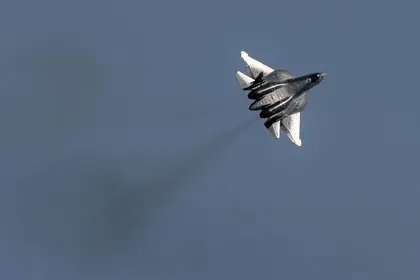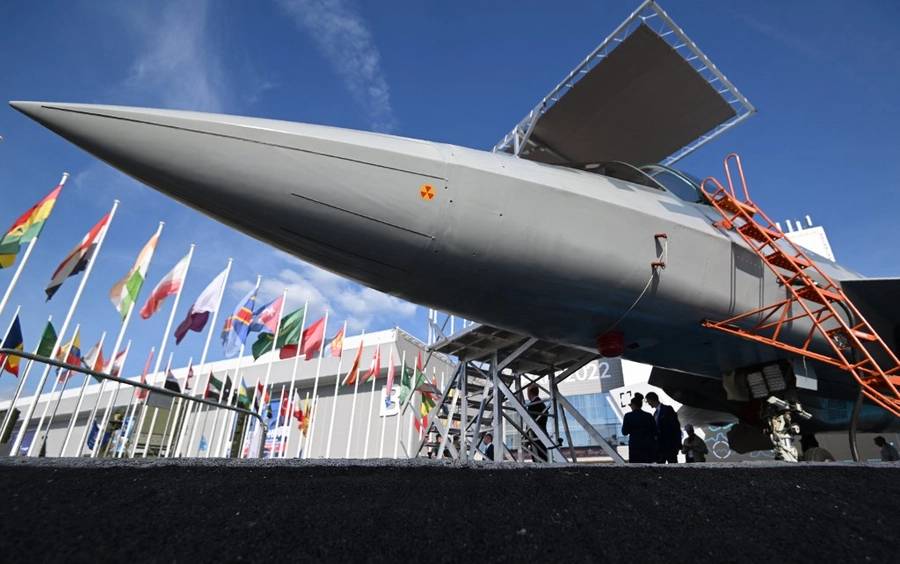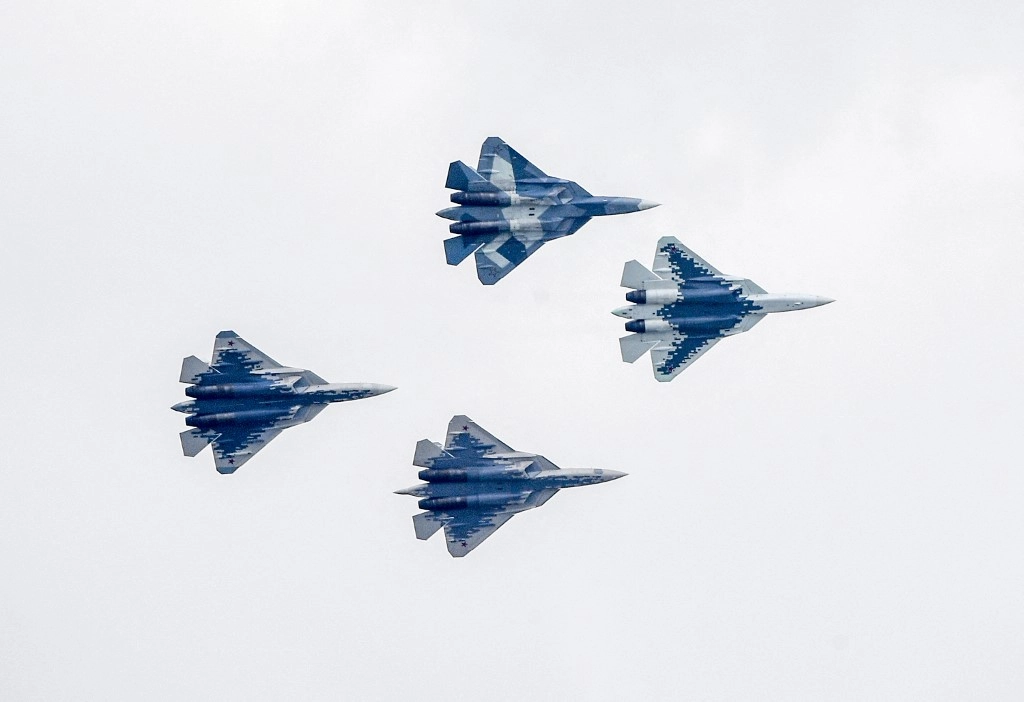Russia’s first and only operational stealth fighter, the Sukhoi Su-57 twin-engine multirole fighter (NATO code name Felon), experienced a ten-year development hell when it officially entered service with the Russian Aerospace Forces (VKS) in 2020.
Being one of only three countries to have developed a stealth fighter (alongside the US and China), Russia had high hopes for the Su-57s and their stealth capabilities, but its ambition for the aircraft was curbed by realities rooted in technical difficulties and budget issues, made worse by Western sanctions after its invasion of Ukraine.
JOIN US ON TELEGRAM
Follow our coverage of the war on the @Kyivpost_official.
Su-57 might be a capable fighter, but the Kremlin appears to have issues utilizing them to their full potential.
Sightings in Ukraine
So far, there have been no confirmed sightings of Su-57 aircraft over Ukraine, but there is speculation that Moscow has used them to attack Ukrainian targets.
On Nov. 5, a Telegram channel claimed that a Su-57 was spotted above Ukraine's eastern battlefield in the Luhansk region.
A British intelligence report in January stated that Russia has “almost certainly used Su-57 FELON to conduct missions against Ukraine.”
Russian state media reported in June 2022 that a Su-57 aircraft conducted combat operations in Ukraine and was tasked with identifying and destroying Ukrainian air defense targets.
Ukrainian Air Force Colonel Yurii Ihnat did not rule out the possibility of Russia using Su-57s against Ukraine, as there are simply no ways to differentiate aircraft on the radar.

VIDEO: 13 Dead, 30 Injured in Russian Aerial Strike on Zaporizhzhia
“For us, air targets are marks on radars,” said Ihnat in an interview.
However, he added that the Russian Air Force boasted a range of aircraft, including Su-25s and Su-35s, that could conduct similar strikes.
It has long been speculated that Russia avoided flying Su-57s over Ukrainian air space in fear of it being shot down by Ukrainian air defenses, as it only has up to 10 of such jets and they remain an extremely valuable asset to its air force.
History of the Su-57 Fighter Jet
A Russian Sukhoi Su-57 is exhibited during the Army-2022 International Military-Technical Forum, on August 16, 2022.NATALIA KOLESNIKOVA / AFP
Development of the Su-57 Felon
The Soviet Union started its own next-generation fighter program to compete with the West in 1979.
The program initially started with two projects, MFI and LFI, which ultimately led to the development of MiG 1.44/1.42 (likely the basis of J-20, China’s current stealth fighter) and Sukhoi Su-47 Berkut that sported a distinctive swept wing design.
However, neither of these was adopted due to budget constraints after the collapse of the Soviet Union, and the programs were ultimately canceled.
Development for Su-57 (under the PAK FA designation, short for “Perspective Aviation-Complex Frontline Aviation”) started in 2001 with an emphasis on replacing both the Su-27 Flankers and MiG 29 Fulcrums in service with the Russian Air Force at the time which remained so to this day.
The jet would ultimately compete against its Western counterparts, F-22 Raptors and F-35 Lightning IIs.
Russia and India entered into a joint development program for a Su-57 derivative, but India withdrew from the program in 2018 because the jet did not meet their requirements.
Prototype and test flights
Initially, the Russian military’s goal was to have the maiden flight by 2007, but it would not happen until 2010 due to development setbacks.
Russia lost a prototype in 2014 and the first Su-57 under serial production in 2019 due to malfunctions. Both pilots survived.
According to an article in 2011, deliveries of the fifth-generation fighter jet were expected by 2016, but in reality, serial production would not begin until 2019 due to numerous technical and logistical issues exacerbated by Western sanctions after Russia's annexation of Crimea in 2014.
Service and planned productions
The jet entered service in 2020, but numbers remain extremely limited with only 11 units known to exist. Western sanctions placed on Russia after its February 2022 invasion of Ukraine are likely to further complicate logistics for Russia and its ability to obtain high-end components required to produce and maintain the aircraft.
Sukhoi Su-57 aircrafts perform during the MAKS 2019 International Aviation and Space Salon opening ceremony in Zhukovsky outside Moscow on August 27, 2019. Alexander NEMENOV / AFPAircraft combat capabilities
Not much is known about Russia’s Su-57’s capabilities as the fighter jet only entered service recently.
Stealth
As a fifth-generation aircraft, it bolstered stealth capabilities that are supposedly on par with its Western counterparts. While critics have claimed that its radar cross-section (RCS) is subpar and similar to the US fourth-generation F/A-18 Super Hornets, but of course this can’t be verified. The RCS is simply a measurement of how big the aircraft’s radar signature is to other radars trying to detect or track it.
Radar
The aircraft is reportedly equipped with advanced avionics suites and technologies, including six radars for improved situational awareness.
Its onboard N036 Byelka radar supposedly has a range of up to 400 km. In comparison, the F-16 jets Ukraine is currently acquiring from its Western allies have up to 296 km in terms of radar range.
Armament
To maintain stealth, weapons are stored in two internal armament bays, and it is able to conduct air-to-air and air-to-ground sorties as a multirole fighter.
It can be equipped with R-77M air-to-air missiles to engage long-range targets and Kh-59MK2 cruise missiles to engage ground targets, among a range of other weaponry.
Russian Defense Minister Sergey Shoigu said a Su-57 test-fired a cruise missile (believed to be a Kh-59MK2) in Syria in 2018.
Engine and speed
Not much is known about the range and speed of current Su-57s in production. However, a report from 2013 said its prototype models (designated as T-50) were able to reach Mach 2.1 supersonic without the use of afterburners.
According to a recent update by Russia’s state media, Rostec (a Russian state-owned conglomerate) announced that a newer second-stage engine called Izdeliye 30 has been fitted to some Su-57 fighter jets, and they are now undergoing flight testing.
The report added that Russia’s Aerospace Forces planned to receive 76 Su-57s by 2027.
You can also highlight the text and press Ctrl + Enter








